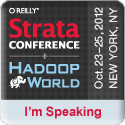Endeca invites customers, partners and leading members of the broader search and discovery technology and solutions communities to meet annually, and showcase the most interesting and exciting work in the field of discovery. As lead for the UX team that designs Endeca’s discovery products, I shared some of our recent work on patterns in the structure of discovery applications, as well as best practices in information design and visualization that we use to drive product definition and design for Endeca’s Latitude Discovery Framework.
This material is useful for program and project managers and business analysts defining requirements for discovery solutions and applications, UX and system architects crafting high-level structures and addressing long-term growth, interaction designers and technical developers defining and building information workspaces at a fine grain, and
There are three major sections: the first presents some of our tools for identifying and understanding people’s needs and goals for discovery in terms of activity (the Language of Discovery as we call it), the second brings together screen-level, application level, and user scenario / use-case level patterns we’ve observed in the applications created to meet those needs, and the final section shares condensed best practices and fundamental principles for information design and visualization based on academic research disciplines such as cognitive science and information retrieval.
It’s no coincidence that these sections reflect the application of the core UX disciplines of user research, information architecture, and interaction design to the question of “who will need to encounter information for some end, and in what kind of experience will they encounter it”. This flow and ordering is deliberate; it demonstrates on two levels the results of our own efforts applying the UX perspective to the questions inherent in creating discovery tools, and shares some of the tools, insights, templates, and resources we use to shape the platform used to create discovery experiences across diverse industries.
Session outline
Session description
“How can you harness the power and flexibility of Latitude to create useful, usable, and compelling discovery applications for enterprise discovery workers? This session goes beyond the technology to explore how you can apply fundamental principles of information design and visualization, analytics best practices and user interface design patterns to compose effective and compelling discovery applications that optimize user discovery, success, engagement, & adoption.”
The patterns are product specific in that they show how to compose screens and applications using the predefined components in the Discovery Framework library. However, many of the product-specific components are built to address common or recurring needs for interaction with information via well-known mechanisms such as search, filtering, navigation, visualization, and presentation of data. In other words, even if you’re not using the literal Discovery Framework component library to compose your specific information analysis workspace, you’ll find these patterns relevant at workspace and application levels of scale.
The deeper story of these patterns is in demonstrating the evolution of discovery and analysis applications over time. Typically, discovery applications begin by offering users a general-purpose workspace that satisfies a wide range of interaction tasks in an approximate fashion. Over time, via successive expansions in the the scope and variety of data they present, and the discovery and analysis capabilities they provide, discovery applications grow to include several different types of workspaces that individually address distinct sets of needs for visualization and sense making by using very different combinations of components. As a composite, these functional and informationally diverse workspaces span the full range of interaction needs for differing types of users.
I hope you find this toolkit and collection of patterns and information design principles useful. What are some of the resources you’re using to take on these challenges?
